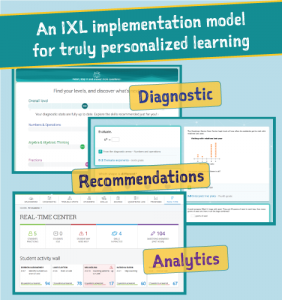Ready to take your IXL experience beyond skills practice? Along with a content library offering thousands of skills, IXL gives you the tools to easily and effectively differentiate learning in your classroom. We’ve put together one implementation model to guide and inspire you to take personalized learning to the next level.
Diagnose your students’ current needs
To identify your students’ current understanding of math, use the IXL Diagnostic, which will pinpoint students’ overall levels, as well as their levels on six individual strands. Even better, these levels stay continuously up to date when students answer just 5 to 10 new questions a week, giving you relevant, actionable data throughout the year. And, as students practice on IXL, that data will also feed into the Diagnostic, so you always have the most accurate picture of their knowledge!
UPDATE: As of May 2018, the IXL Continuous Diagnostic also includes English Language Arts! In addition to the six math strands, the Diagnostic now measures student understanding in four ELA strands.

 Get spot-on recommendations for what to work on
Get spot-on recommendations for what to work on
Next, have students visit their Recommendations wall as a bell ringer exercise, station rotation, or post-classwork activity. Here, they’ll find a variety of skills that are selected just for them! Recommendations include skills that the Diagnostic has identified as the next best steps for students to grow, as well as new topics for students to explore, concepts to keep working on, and more (see a list of all the types to the left). This is a great way to encourage student agency and have students take responsibility for what skills to work on next.

Keep tabs on student progress to step in at the right time
Now that your students have practice data on IXL, head to IXL Analytics to see how they’ve been doing. Not only can you monitor student progress, but you can also address trouble spots, dive deep into the specific questions students answered, or display student practice in real time so that you can intervene in the moment.

Do you have any tips on how you use IXL in your classroom?
